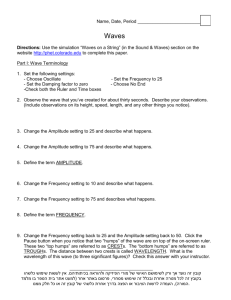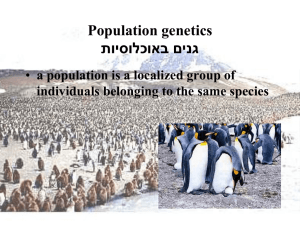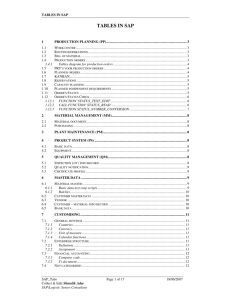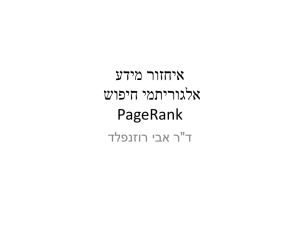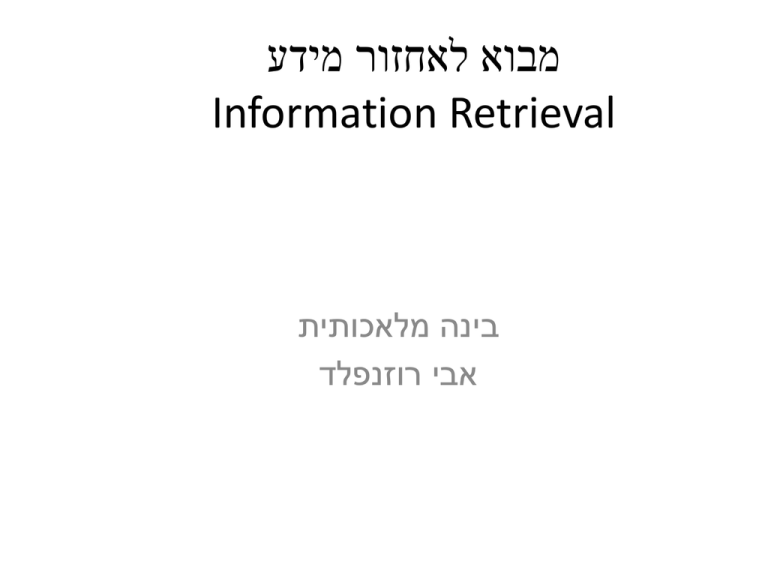
מבוא לאחזור מידע
Information Retrieval
בינה מלאכותית
אבי רוזנפלד
מהי אחזור מידע?
• חיפוש אחרי מידע באינטרנט
– הרב ד"ר גוגל ((?BING
– תחום מחקר פורח וחשובה...
• חיפוש אחרי מידע רלוונטי מתוך הרבה מקורות
(אתרים ,תמונה ,וכו')
Copyright © Victor Lavrenko
Hopkins IR Workshop 2005
מה ההבדל בין שאילתות
?בבסיסי נתונים ואחזור מידע
בסיסי נתונים
Data Structured (key)
Clear semantics
Fields (SSN, age)
Defined (relational
Queries algebra, SQL)
Exact (results are
Matching always “correct”(
Hopkins IR Workshop 2005
Copyright © Victor Lavrenko
אחזור מידע
Unstructured (web)
No fields (other than text)
Free text )“natural
language”(, Boolean
Imprecise (need to
measure effectiveness)
מערכת המידע של אחזור מידע
Document
corpus
IR
System
Query
String
Ranked
Documents
4
1. Doc1
2. Doc2
3. Doc3
.
.
שלבים למנוע חיפוש
• בניית המאגר מידע )(Document Corpus
–
–
–
–
Web crawler
ניקיון המידע מכפילותSTEMMING ,
תדירות המילים
חשיבות המילים – Td/IDF
• בניית האנדקסים (לאנדקס )Index
• בניית התשובה
– עיבוד השאלתה (הורדת )STOP WORDS
– דירוג תוצאות ()PAGERANK
• ניתוח התוצאות
– FALSE NEGATIVE /FALSE POSITIVE
– Recall / Precision
בניית הINDEX
דוגמאות – שימו לב לזמן ומספר התוצאות!
זחלן רשת Web Crawler /
– Identifies and acquires documents for search engine
– http://en.wikipedia.org/wiki/Web_crawler
•
•
•
•
•
זחלן רשת הוא סוג של בוט או תוכנה שסורקת באופן
אוטומטי ושיטתי את ה.WWW
מדיניות של בחירה אשר מגדירה איזה עמוד להוריד.
מדיניות של ביקור חוזר אשר מגדירה מתי לבדוק
שינויים בדפים.
מדיניות נימוס אשר מגדירה איך להימנע מעומס יתר
של אתרים ולגרום להפלה של השרת.
מדיניות של הקבלה אשר מגדירה איך לתאם בין
הזחלנים השונים.
דחיסה-- ניקיון המידע
• Text is highly redundant (or predictable)
• Compression techniques exploit this redundancy
to make files smaller without losing any of the
content
• Compression of indexes covered later
• Popular algorithms can compress HTML and XML
text by 80%
– e.g., DEFLATE (zip, gzip) and LZW (UNIX compress,
PDF)
– may compress large files in blocks to make access
faster
רעש-- ניקיון המידע
• Many web pages contain text, links, and
pictures that are not directly related to the
main content of the page
• This additional material is mostly noise that
could negatively affect the ranking of the page
• Techniques have been developed to detect
the content blocks in a web page
– Non-content material is either ignored or reduced
in importance in the indexing process
Noise Example
Example Web Page
Example Web Page
ניקיון המידע – מציאת מידע חשוב
• Tokenizer recognizes “words” in the text
– Must consider issues like capitalization, hyphens,
apostrophes, non-alpha characters, separators
• Markup languages such as HTML, XML often
used to specify structure and metatags
– Tags used to specify document elements
– E.g., <h2> Overview </h2>
– Document parser uses syntax of markup language
(or other formatting) to identify structure
דירוג הנתונים
• מידע סטטיסטי של המסמכים
– מספר הפעמים שמילים הופיעו ,מיקום במסמך
• משקל למילים
– tf.idf weight
– שילוב של התדירות של מילה במסמך ובכל המאגר
Zipf חוק
• יש התפלגות לא נורמאלית למלים בשפה
)– הרבה מילים מופיעים הרבה (ואפילו רוב הזמן
= מילים שמופיעים הרבה ולכן לא חשוביםStopwords –
בחיפוש
e.g., two most common words (“the”, “of”) make up –
about 10% of all word occurrences in text documents
• Zipf’s “law”:
– observation that rank (r) of a word times its frequency
(f) is approximately a constant (k)
• assuming words are ranked in order of decreasing frequency
– i.e., r.f k or r.Pr c, where Pr is probability of word
occurrence and c 0.1 for English
Zipf’s Law
tf*idf weighting schema
• tf = term frequency
–
frequency of a term/keyword in a document
The higher the tf, the higher the importance (weight) for the doc.
• df = document frequency
– no. of documents containing the term
– distribution of the term
• idf = inverse document frequency
– the unevenness of term distribution in the corpus
– the specificity of term to a document
The more the term is distributed evenly, the less it is specific to a
document
weight(t,D) = tf(t,D) * idf(t)
18
דוגמא
• נניח שהמילה exampleהופיע 3פעמים בתוך מסמך
א' מתוך 4מסמכים
–
–
–
–
( Tf= 3במסמך הזה)
Idf = 1/0.25= 4
Tf*idf=12
מה יקרה אם המילה מופיע בכל מסמך?
• מה יהיה ה)3( ?tf*idf
• יש כמה וריאציות איך לחשב tfו( idfכמו ב )LOGאבל
זה הכי פשט
• נשתמש בו בתוך התרגיל
Stopwords / Stoplist
• function words do not bear useful information for IR
of, in, about, with, I, although, …
• Stoplist: contain stopwords, not to be used as index
–
–
–
–
–
Prepositions
Articles
Pronouns
Some adverbs and adjectives
Some frequent words (e.g. document)
• The removal of stopwords usually improves IR
effectiveness
• A few “standard” stoplists are commonly used.
20
Top 50 Words from AP89
Stemming
• Reason:
– Different word forms may bear similar meaning (e.g. search,
searching): create a “standard” representation for them
• Stemming:
– Removing some endings of word
computer
compute
computes
computing
computed
computation
comput
22
Stemming
• Generally a small but significant effectiveness
improvement
– can be crucial for some languages
– e.g., 5-10% improvement for English, up to 50% in
Arabic
Words with the Arabic root ktb
Stemming
• Two basic types
– Dictionary-based: uses lists of related words
– Algorithmic: uses program to determine related
words
• Algorithmic stemmers
– suffix-s: remove ‘s’ endings assuming plural
• e.g., cats → cat, lakes → lake, wiis → wii
• Many false negatives: supplies → supplie
• Some false positives: ups → up
Porter algorithm
(Porter, M.F., 1980, An algorithm for suffix stripping, Program, 14(3)
:130-137)
• Step 1: plurals and past participles
– SSES -> SS
– (*v*) ING ->
caresses -> caress
motoring -> motor
• Step 2: adj->n, n->v, n->adj, …
– (m>0) OUSNESS -> OUS callousness -> callous
– (m>0) ATIONAL -> ATE
relational -> relate
• Step 3:
– (m>0) ICATE -> IC
triplicate -> triplic
• Step 4:
– (m>1) AL ->
– (m>1) ANCE ->
revival -> reviv
allowance -> allow
• Step 5:
– (m>1) E ->
probate -> probat
– (m > 1 and *d and *L) -> single letter
controll -> control
25
N-Grams
• Frequent n-grams are more likely to be
meaningful phrases
• N-grams form a Zipf distribution
– Better fit than words alone
• Could index all n-grams up to specified length
– Much faster than POS tagging
– Uses a lot of storage
• e.g., document containing 1,000 words would contain
3,990 instances of word n-grams of length 2 ≤ n ≤ 5
עוד שיטות...
• דירוג לפי ( n-gramאוסף של מילים באורך )n
• דירוג לפי סוג המילה (פעולה ,שם עצם וכו')
– )POS( Part of Speech
Google N-Grams
• Web search engines index n-grams
• Google sample:
• Most frequent trigram in English is “all rights
reserved”
– In Chinese, “limited liability corporation”
דירוג תוצאות
• Early IR focused on set-based retrieval
– Boolean queries, set of conditions to be satisfied
– document either matches the query or not
• like classifying the collection into relevant / non-relevant
sets
– still used by professional searchers
– “advanced search” in many systems
• Modern IR: ranked retrieval
– free-form query expresses user’s information need
– rank documents by decreasing likelihood of relevance
– many studies prove it is superior
Hopkins IR Workshop 2005
Copyright © Victor Lavrenko

